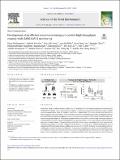| dc.contributor.author | Mailepessov, Diyar | |
| dc.contributor.author | Arivalan, Sathish | |
| dc.contributor.author | Kong, Marcella | |
| dc.contributor.author | Griffiths, Jane | |
| dc.contributor.author | Low, Swee Ling | |
| dc.contributor.author | Chen, Hongjie | |
| dc.contributor.author | Hapuarachchi, Hapuarachchige Chanditha | |
| dc.contributor.author | Gu, Xiaoqiong | |
| dc.contributor.author | Lee, Wei Lin | |
| dc.contributor.author | Alm, Eric J | |
| dc.contributor.author | Thompson, Janelle | |
| dc.contributor.author | Wuertz, Stefan | |
| dc.contributor.author | Gin, Karina | |
| dc.contributor.author | Ng, Lee Ching | |
| dc.contributor.author | Wong, Judith Chui Ching | |
| dc.date.accessioned | 2023-01-26T14:24:37Z | |
| dc.date.available | 2023-01-26T14:24:37Z | |
| dc.date.issued | 2022 | |
| dc.identifier.uri | https://hdl.handle.net/1721.1/147722 | |
| dc.description.abstract | Wastewater-based surveillance has been widely used as a non-intrusive tool to monitor population-level transmission of COVID-19. Although various approaches are available to concentrate viruses from wastewater samples, scalable methods remain limited. Here, we sought to identify and evaluate SARS-CoV-2 virus concentration protocols for high-throughput wastewater testing. A total of twelve protocols for polyethylene glycol (PEG) precipitation and four protocols for ultrafiltration-based approaches were evaluated across two phases. The first phase entailed an initial evaluation using a small sample set, while the second phase further evaluated five protocols using wastewater samples of varying SARS-CoV-2 concentrations. Permutations in the pre-concentration, virus concentration and RNA extraction steps were evaluated. Among PEG-based methods, SARS-CoV-2 virus recovery was optimal with 1) the removal of debris prior to processing, 2) 2 h to 24 h incubation with 8% PEG at 4 °C, 3) 4000 xg or 14,000 xg centrifugation, and 4) a column-based RNA extraction method, yielding virus recovery of 42.4-52.5%. Similarly, the optimal protocol for ultrafiltration included 1) the removal of debris prior to processing, 2) ultrafiltration, and 3) a column-based RNA extraction method, yielding a recovery of 38.2%. This study also revealed that SARS-CoV-2 RNA recovery for samples with higher virus concentration were less sensitive to changes in the PEG method, but permutations in the PEG protocol could significantly impact virus yields when wastewater samples with lower SARS-CoV-2 RNA were used. Although both PEG precipitation and ultrafiltration methods resulted in similar SARS-CoV-2 RNA recoveries, the former method is more cost-effective while the latter method provided operational efficiency as it required a shorter turn-around-time (PEG precipitation, 9-23 h; Ultrafiltration, 5 h). The decision on which method to adopt will thus depend on the use-case for wastewater testing, and the need for cost-effectiveness, sensitivity, operational feasibility and scalability. | en_US |
| dc.language.iso | en | |
| dc.publisher | Elsevier BV | en_US |
| dc.relation.isversionof | 10.1016/J.SCITOTENV.2022.154024 | en_US |
| dc.rights | Creative Commons Attribution-NonCommercial-NoDerivs License | en_US |
| dc.rights.uri | http://creativecommons.org/licenses/by-nc-nd/4.0/ | en_US |
| dc.source | Elsevier | en_US |
| dc.title | Development of an efficient wastewater testing protocol for high-throughput country-wide SARS-CoV-2 monitoring | en_US |
| dc.type | Article | en_US |
| dc.identifier.citation | Mailepessov, Diyar, Arivalan, Sathish, Kong, Marcella, Griffiths, Jane, Low, Swee Ling et al. 2022. "Development of an efficient wastewater testing protocol for high-throughput country-wide SARS-CoV-2 monitoring." Science of the Total Environment, 826. | |
| dc.contributor.department | Massachusetts Institute of Technology. Department of Biological Engineering | en_US |
| dc.relation.journal | Science of the Total Environment | en_US |
| dc.eprint.version | Final published version | en_US |
| dc.type.uri | http://purl.org/eprint/type/JournalArticle | en_US |
| eprint.status | http://purl.org/eprint/status/PeerReviewed | en_US |
| dc.date.updated | 2023-01-26T14:20:13Z | |
| dspace.orderedauthors | Mailepessov, D; Arivalan, S; Kong, M; Griffiths, J; Low, SL; Chen, H; Hapuarachchi, HC; Gu, X; Lee, WL; Alm, EJ; Thompson, J; Wuertz, S; Gin, K; Ng, LC; Wong, JCC | en_US |
| dspace.date.submission | 2023-01-26T14:20:15Z | |
| mit.journal.volume | 826 | en_US |
| mit.license | PUBLISHER_CC | |
| mit.metadata.status | Authority Work and Publication Information Needed | en_US |
